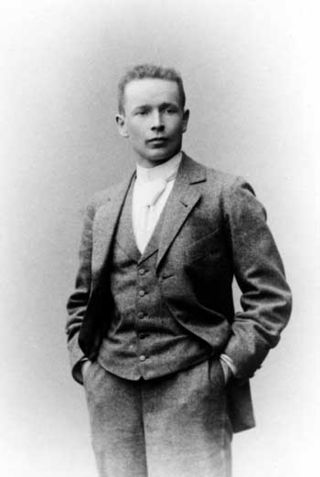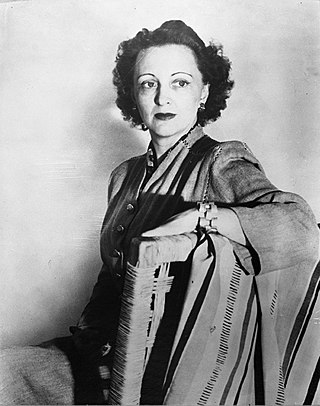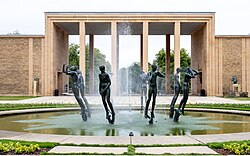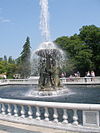
Eero Saarinen was a Finnish-American architect and industrial designer who created a wide array of innovative designs for buildings and monuments, including General Motors Technical Center in Warren, Michigan; the passenger terminal at Dulles International Airport outside Washington, D.C.; the TWA Flight Center at John F. Kennedy International Airport; and the Gateway Arch in St. Louis. He was the son of Finnish architect Eliel Saarinen.

Bloomfield Hills is a city in Oakland County in the U.S. state of Michigan. A northern suburb of Detroit on the Woodward Corridor, Bloomfield Hills is located roughly 20 miles (32.2 km) northwest of downtown Detroit, and is surrounded on most sides by Bloomfield Township. As of the 2020 census, the city had a population of 4,460.
Cranbrook Schools is a private PK–12 educational institution located on a 319-acre (129 ha) campus in Bloomfield Hills, Michigan. It includes a co-educational elementary school, a middle school with separate schools for boys and girls, and a co-educational college-preparatory high school with boarding facilities. Cranbrook Schools is part of the Cranbrook Educational Community (CEC), which includes the Cranbrook Institute of Science, the Cranbrook Academy of Art, and Cranbrook House and Gardens. Christ Church Cranbrook is also on campus. The Cranbrook community was established by publishing mogul George Booth, who bought the site of today's Cranbrook community in 1904. Cranbrook was designated a National Historic Landmark on June 29, 1989, for its significant architecture and design. It attracts tourists from around the world. Approximately 40 acres (160,000 m2) of Cranbrook Schools' campus are gardens.

Gottlieb Eliel Saarinen was a Finnish-American architect known for his work with art nouveau buildings in the early years of the 20th century. He was also the father of famed architect Eero Saarinen.

George Gough Booth was the publisher of the privately held Evening News Association, a co-founder of Booth Newspapers, and a philanthropist.

Florence Marguerite Knoll Bassett was an American architect, interior designer, furniture designer, and entrepreneur who has been credited with revolutionizing office design and bringing modernist design to office interiors. Knoll and her husband, Hans Knoll, built Knoll Associates into a leader in the fields of furniture and interior design. She worked to professionalize the field of interior design, fighting against gendered stereotypes of the decorator. She is known for her open office designs, populated with modernist furniture and organized rationally for the needs of office workers. Her modernist aesthetic was known for clean lines and clear geometries that were humanized with textures, organic shapes, and colour.

Balthazar Korab was a Hungarian-American photographer based in Detroit, Michigan, specializing in architectural, art and landscape photography.

The A. Alfred Taubman College of Architecture and Urban Planning, also known as Taubman College, is the school of urban planning and one of the nineteen schools of the University of Michigan located in Ann Arbor, Michigan.

The GM Technical Center was inaugurated in 1956 as General Motors's primary design and engineering center, located in Warren, Michigan.

Christ Church Lutheran is a congregation of the Evangelical Lutheran Church in America (ELCA) in Minneapolis. Its buildings—a sanctuary with chapel (1949) and an education wing (1962) designed by Finnish-American architects Eliel Saarinen and Eero Saarinen—have been internationally recognized, most recently in 2009 as a National Historic Landmark by the U.S Department of the Interior.

The architecture of metropolitan Detroit continues to attract the attention of architects and preservationists alike. With one of the world's recognizable skylines, Detroit's waterfront panorama shows a variety of architectural styles. The post-modern neogothic spires of One Detroit Center refer to designs of the city's historic Art Deco skyscrapers. Together with the Renaissance Center, they form the city's distinctive skyline.

Mary Chase Perry Stratton was an American ceramic artist. She was a co-founder, along with Horace James Caulkins, of Pewabic Pottery, a form of ceramic art used to make architectural tiles.
Lilian Louisa Swann Saarinen was an American sculptor, artist, and writer. She was the first wife of Finnish-American architect and industrial designer Eero Saarinen, with whom she sometimes collaborated.
Don Charles Albinson was an American industrial designer who made many contributions to the world of furniture. He worked with Charles and Ray Eames for 13 years, helping develop many of the seminal Herman Miller furniture pieces from the mid century – the bent plywood chair, the fiberglass shell chair, the aluminum group set, and the Eames Lounge chair, to name a few. He later developed the Knoll Stack chair, the Westinghouse office line, an update to the DoMore Series 7 landscape system named Neo 7, the Albi stack chair for Fixtures, and the Bounce chair for Stylex.

Marianne Strengell was an influential Finnish-American Modernist textile designer in the twentieth century. Strengell was a professor at Cranbrook Academy of Art from 1937 to 1942, and she served as department head from 1942 to 1962. She was able to translate hand-woven patterns for mechanized production, and pioneered the use of synthetic fibers.
Ruth Adler Schnee was a German-born American textile designer and interior designer based in Michigan. Schnee was best known for her modern prints and abstract-patterns of organic and geometric forms. She opened the Ruth Adler-Schnee Design Studio with her spouse Edward Schnee in Detroit, which operated until 1960. The studio produced textiles and later branched off into Adler-Schnee Associates home decor, interiors, and furniture.

Minna Carolina Mathilde Louise "Loja" Gesellius(March 15, 1879 – April 21, 1968) was a Finnish-American textile artist and sculptor. She founded the weaving department at the Cranbrook Academy of Art in Michigan. She also led her own studio, the Studio Loja Saarinen, which designed many of the textiles used in buildings designed by her husband, the architect Eliel Saarinen.

Eva-Lisa "Pipsan" Saarinen Swanson (March 31, 1905 – October 23, 1979) was a Finnish-American industrial, interior, and textile designer based in Michigan. She was known for her contemporary furniture, textile, and product designs.
The Cranbrook Academy of Art is the art school of the Cranbrook Educational Community, founded by George Gough Booth and Ellen Scripps Booth. Located in Bloomfield Hills, Michigan, it grants MFA or MArch degrees to students who have completed a two-year course in 2D Design, 3D Design, 4D Design, Architecture, Ceramics, Fibers, Metals, Painting, Photography, Print Media, or Sculpture. Described as an "educational experiment", each department is led by an Artist-in-Residence, who acts as mentor, advisor, and professor to the students in that department. Cranbrook is closely tied to the Arts and Crafts movement in America.


























